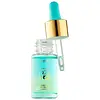What's inside
What's inside
 Key Ingredients
Key Ingredients

 Benefits
Benefits

 Concerns
Concerns

 Ingredients Side-by-side
Ingredients Side-by-side

Water
Skin ConditioningEthylhexyl Palmitate
EmollientCoconut Alkanes
EmollientIsopropyl Myristate
EmollientShea Butter Ethyl Esters
EmollientNeopentyl Glycol Diheptanoate
EmollientGlycerin
HumectantIsododecane
EmollientPersea Gratissima Oil
Skin ConditioningCocos Nucifera Oil
MaskingCamellia Japonica Seed Oil
EmollientArgania Spinosa Kernel Oil
EmollientPentylene Glycol
Skin ConditioningCoco-Caprylate/Caprate
EmollientPassiflora Edulis Seed Oil
EmollientPhenoxyethanol
PreservativeKappaphycus Alvarezii Extract
Skin ConditioningLaminaria Digitata Extract
Skin ProtectingSea Water Extract
Skin ConditioningSpirulina Maxima Extract
SmoothingLeuconostoc/Radish Root Ferment Filtrate
AntimicrobialChondrus Crispus Extract
Skin ConditioningHydroxyacetophenone
AntioxidantCollagen Amino Acids
MoisturisingAlgae Extract
EmollientCitrus Sinensis Peel Oil Expressed
PerfumingAphanizomenon Flos-Aquae Extract
HumectantLimonene
PerfumingLavandula Angustifolia Oil
MaskingGardenia Taitensis Flower Extract
Skin ConditioningEthylhexylglycerin
Skin ConditioningMelia Azadirachta Leaf Extract
Skin ConditioningMelia Azadirachta Flower Extract
Skin ConditioningLinalool
PerfumingGluconolactone
Skin ConditioningSodium Benzoate
MaskingArginine
MaskingPotassium Sorbate
PreservativeCorallina Officinalis Extract
Skin ConditioningTocopherol
AntioxidantPopulus Tremuloides Bark Extract
AntiseborrhoeicCoccinia Indica Fruit Extract
Skin ConditioningSodium Hyaluronate
HumectantSolanum Melongena Fruit Extract
Skin ConditioningAloe Barbadensis Flower Extract
EmollientSimmondsia Chinensis Seed Oil
EmollientCurcuma Longa Root Extract
MaskingOcimum Basilicum Flower/Leaf Extract
TonicOcimum Sanctum Leaf Extract
Skin ConditioningCitric Acid
BufferingWater, Ethylhexyl Palmitate, Coconut Alkanes, Isopropyl Myristate, Shea Butter Ethyl Esters, Neopentyl Glycol Diheptanoate, Glycerin, Isododecane, Persea Gratissima Oil, Cocos Nucifera Oil, Camellia Japonica Seed Oil, Argania Spinosa Kernel Oil, Pentylene Glycol, Coco-Caprylate/Caprate, Passiflora Edulis Seed Oil, Phenoxyethanol, Kappaphycus Alvarezii Extract, Laminaria Digitata Extract, Sea Water Extract, Spirulina Maxima Extract, Leuconostoc/Radish Root Ferment Filtrate, Chondrus Crispus Extract, Hydroxyacetophenone, Collagen Amino Acids, Algae Extract, Citrus Sinensis Peel Oil Expressed, Aphanizomenon Flos-Aquae Extract, Limonene, Lavandula Angustifolia Oil, Gardenia Taitensis Flower Extract, Ethylhexylglycerin, Melia Azadirachta Leaf Extract, Melia Azadirachta Flower Extract, Linalool, Gluconolactone, Sodium Benzoate, Arginine, Potassium Sorbate, Corallina Officinalis Extract, Tocopherol, Populus Tremuloides Bark Extract, Coccinia Indica Fruit Extract, Sodium Hyaluronate, Solanum Melongena Fruit Extract, Aloe Barbadensis Flower Extract, Simmondsia Chinensis Seed Oil, Curcuma Longa Root Extract, Ocimum Basilicum Flower/Leaf Extract, Ocimum Sanctum Leaf Extract, Citric Acid
Ingredients Explained
These ingredients are found in both products.
Ingredients higher up in an ingredient list are typically present in a larger amount.
Algae Extract is a confusing name. This is because algae is an informal term for a group of 30,000 aquatic organisms that can photosynthesize.
The term 'algae extract' can refer to any one, or a blend of, the 30,000 types.
Algae is rich in antioxidants. Antioxidants help fight free-radicals. Free-radicals are molecules that may damage your skin cells, such as pollution.
Algae can also help with soothing and hydrating skin.
Many different types of algae have different benefits.
Learn more about Algae ExtractGlycerin is already naturally found in your skin. It helps moisturize and protect your skin.
A study from 2016 found glycerin to be more effective as a humectant than AHAs and hyaluronic acid.
As a humectant, it helps the skin stay hydrated by pulling moisture to your skin. The low molecular weight of glycerin allows it to pull moisture into the deeper layers of your skin.
Hydrated skin improves your skin barrier; Your skin barrier helps protect against irritants and bacteria.
Glycerin has also been found to have antimicrobial and antiviral properties. Due to these properties, glycerin is often used in wound and burn treatments.
In cosmetics, glycerin is usually derived from plants such as soybean or palm. However, it can also be sourced from animals, such as tallow or animal fat.
This ingredient is organic, colorless, odorless, and non-toxic.
Glycerin is the name for this ingredient in American English. British English uses Glycerol/Glycerine.
Learn more about GlycerinPhenoxyethanol is a preservative that has germicide, antimicrobial, and aromatic properties. Studies show that phenoxyethanol can prevent microbial growth. By itself, it has a scent that is similar to that of a rose.
It's often used in formulations along with Caprylyl Glycol to preserve the shelf life of products.
Sodium Hyaluronate is hyaluronic acid's salt form. It is commonly derived from the sodium salt of hyaluronic acid.
Like hyaluronic acid, it is great at holding water and acts as a humectant. This makes it a great skin hydrating ingredient.
Sodium Hyaluronate is naturally occurring in our bodies and is mostly found in eye fluid and joints.
These are some other common types of Hyaluronic Acid:
Learn more about Sodium HyaluronateWater. It's the most common cosmetic ingredient of all. You'll usually see it at the top of ingredient lists, meaning that it makes up the largest part of the product.
So why is it so popular? Water most often acts as a solvent - this means that it helps dissolve other ingredients into the formulation.
You'll also recognize water as that liquid we all need to stay alive. If you see this, drink a glass of water. Stay hydrated!
Learn more about Water